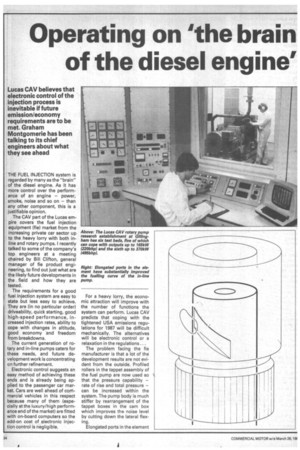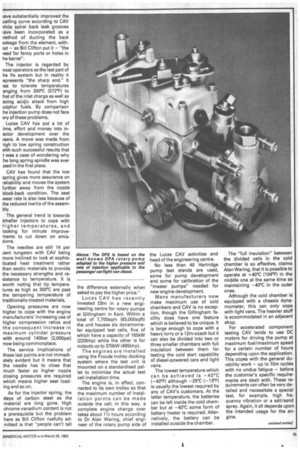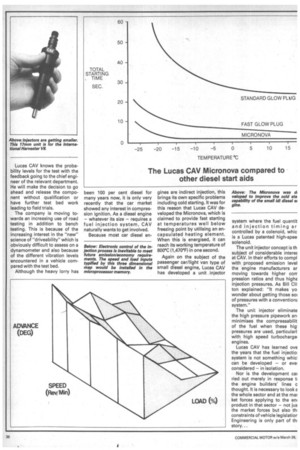Operating on 'the brain of the diesel engine'
Page 36

Page 37

Page 38

If you've noticed an error in this article please click here to report it so we can fix it.
Lucas CAV believes that electronic control of the injection process is inevitable if future emission/economy requirements are to be met. Graham Montgomerie has been talking to its chief engineers about what they see ahead
THE FUEL INJECTION system is regarded by many as the "brain" of the diesel engine. As it has more control over the performance of an engine — power, smoke, noise and so on — than any other component, this is a justifiable opinion.
The CAV part of the Lucas empire covers the fuel injection equipment (fie) market from the increasing private car sector up to the heavy lorry with both inline and rotary pumps. I recently talked to some of the company's top engineers at a meeting chaired by Bill Clifton, general manager of fie product engineering, to find out just what are the likely future developments in the field and how they are tested.
The requirements for a good fuel injection system are easy to state but less easy to achieve. They are (in no particular order) driveability, quick starting, good high-speed performance, increased injection rates, ability to cope with changes in altitude, good economy and freedom from breakdowns.
The current generation of rotary and in-line pumps caters for these needs, and future development work is concentrating on further refinement.
Electronic control suggests an easy method of achieving these ends and is already being applied to the passenger car market. Cars are well ahead of commercial vehicles in this respect because many of them (especially at the luxury/high performance end of the market) are fitted with on-board computers so the add-on cost of electronic injection control is negligible. For a heavy lorry, the economic attraction will improve with the number of functions the system can perform. Lucas CAV predicts that coping with the tightened USA emissions regulations for 1987 will be difficult mechanically. The alternatives will be electronic control or a relaxation in the regulations ...
The problem facing the fie manufacturer is that a lot of the development results are not evident from the outside. Profiled rollers in the tappet assembly of the fuel pump are now used so that the pressure capability — rate of rise and total pressure — can be increased within the system. The pump body is much stiffer by rearrangement of the tappet boxes in the cam box which improves the noise level by cutting down the lateral flexing.
Elongated ports in the element lave substantially improved the uelling curve according to CAV vhile spiral back leak grooves lave been incorporated as a nethod of ducting the back eakage from the element, withwt as Bill Clifton put it — "the heed for fancy ports or holes in he barrel".
The injector is regarded by nost operators as the last part of he fie system but in reality it epresents "the sharp end." It las to tolerate temperatures anging from 300°C (572°F) to hat of the inlet charge as well as acing aciqic attack from high lulphur fuels. By comparison he injection pump does not face my of these problems.
Lucas CAV has put a lot of ime, effort and money into inector development over the fears. A move was made from ugh to low spring construction rvith such successful results that t was a case of wondering why he long spring spindle was ever Jsed in the first place. .
CAV has found that the low spring gives more assurance on reliability and moves the system Further away from the nozzle block-back condition. The seat wear rate is also less because of the reduced inertia of the assembly.
The general trend is towards smaller injectors to cope with nigher temperatures, and looking for minute improvements to cut down on emissions.
The needles are still 14 per cent tungsten with CAV being more 'inclined to look at sophisticated heat treatment rather than exotic materials to provide the necessary strengths and resistance to temperature. It is worth noting that tip temperatures as high as 300°C are past the tempering temperature of traditionally-treated materials.
Opening pressures are now higher to cope with the engine manufacturers' increasing use of higher compression ratios and the consequent increase in maximum cylinder pressure with around 140bar (2,000psi) now being commonplace.
The service implications of these last points are not immediately evident but it means that the needle has to close that much faster so higher nozzle closing pressures are required which means higher seat loading and so on.
As for the injector spring, the days of carbon steel as the material are long gone. High chrome vanadium content is not a prerequisite but the problem here as Bill Clifton ruefully admitted is that "people can't tell the difference externally when asked to pay the higher price."
Lucas CAV has recently invested £8m in a new engineering centre for rotary pumps at Gillingham in Kent. Within a total of 7,700sqm (83,000sqft) the unit houses six dynamometer equipped test cells, five of which have a capacity of 165kW (220bhp) while the other is for outputs up to 370kW (495bhp).
The engines are installed using the Froude trolley docking system where the test unit is mounted on a standardised pallet to minimise the actual test cell installation time.
The engine is, in effect, connected to its own trolley so that the maximum number of installation points can be made outside the cell. In this way, a complete engine change over takes about 11/2 hours according to Dr Alan Waring, chief engineer of the rotary pump side of
the Lucas CAV activities and head of the engineering centre.
No less than 40 Hartridge pump test stands are used, some for pump development and some for calibration of the "master pumps" needed for new engine development.
Many manufacturers now make maximum use of cold chambers and CAV is no exception, though the Gillingham facility does have one feature which is believed to be unique. It is large enough to cope with a heavy lorry or a 12m-coach but it can also be divided into two or three smaller chambers with full insulation between them for testing the cold start capability of diesel-powered cars and light vans.
The lowest temperature which can be achieved is —40°C (-40°F) although —25°C (-13°F) is usually the lowest required by any of CAV's customers. At the latter temperature, the batteries can be left inside the cold chamber but at —40°C some form of battery heater is required. Alternatively, the battery can be installed outside the chamber.
The "full insulation" between the divided cells in the cold chamber is so effective, claims Alan Waring, that it is possible to operate at +40°C (104°F) in the middle one at the same time as maintaining —40°C in the outer ones.
Although the cold chamber is equipped with a chassis dynamometer, this can only cope with light vans. The heavier stuff is accommodated in an adjacent shop.
For accelerated component testing CAV tends to use DC motors for driving the pump at maximum fuel/maximum speed for a certain number of hours depending upon the application. This copes with the general durability work — up to 10m cycles with no undue fatigue — before the customer's specific requirements are dealt with. These requirements can often be very detailed and necessitate a special test, for example, high frequency vibration or a salt/sand spray. Again, it all depends upon the intended usage for the engine. Lucas CAV knows the probability levels for the test with the feedback going to the chief engineer of the relevant department. He will make the decision to go ahead and release the component without qualification or have further test bed work leading to field trials.
The company is moving towards an increasing use of road testing in addition to bench testing. This is because of the increasing interest in the "new" science of "driveability" which is obviously difficult to assess on a dynamometer and also because of the different vibration levels encountered in a vehicle compared with the test bed.
Although the heavy lorry has been 100 per cent diesel for many years now, it is only very recently that the car market showed any interest in cornpression ignition. As a diesel engine whatever its size requires a fuel injection system, CAV naturally wants to get involved.
Because most car diesel en gines are indirect injection, this brings its own specific problems including cold starting. It was for this reason that Lucas CAV developed the Micronova, which is claimed to provide fast starting at temperatures well below freezing point by utilising an encapsulated heating element. When this is energised, it can reach its working temperature of 800°C (1,470°F) in one second.
Again on the subject of the passenger car/light van type of small diesel engine, Lucas CAV has developed a unit injector
system where the fuel quantit and injection timing ar controlled by a colenoid, whic is a Lucas patented high-spee, solenoid.
The unit injector concept is th subject of considerable interev. at CAV. In their efforts to compl with proposed emission level the engine manufacturers ar moving towards higher corr pression ratios and thus highe injection pressures. As Bill CHI ton explained: "It makes yo wonder about getting those soi of pressures with a conventionz system."
The unit injector eliminate the high pressure pipework minimises the cornpressabilit of the fuel when these hig: pressures are used, particularl with high speed turbochargei engines.
Lucas CAV has learned ove the years that the fuel injectio: system is not something whicl can be developed or eve: considered in isolation.
Nor is the development car ried out merely in response ti the engine builders' lines o thought. It is necessary to look a the whole sector and at the mat ket forces applying to the em product in that sector not jus the market forces but also till constraints of vehicle legislatior Engineering is only part of thi story...
















































































